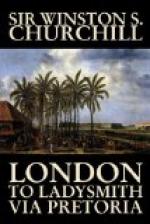Not yet convinced, General Buller, pressing forward, moved the whole of his infantry, with the exception of Barton’s Brigade, and nearly all the artillery, heavy and field, across the river, and in the afternoon sent two battalions from Norcott’s Brigade and the Lancashire Brigade—to the vacant command of which Colonel Kitchener had been appointed—forward against the low kopjes. By nightfall a good deal of this low, rolling ground was in our possession, though at some cost in men and officers.
At dusk the Boers made a fierce and furious counter-attack. I was watching the operations from Hlangwani Hill through a powerful telescope. As the light died my companions climbed down the rocks to the Cavalry camp and left me alone staring at the bright flashes of the guns which stabbed the obscurity on all sides. Suddenly, above the booming of the cannon, there arose the harsh rattling roar of a tremendous fusillade. Without a single intermission this continued for several hours. The Howitzer Battery, in spite of the darkness, evidently considered the situation demanded its efforts, and fired salvoes of lyddite shells, which, bursting in the direction of the Boer positions, lit up the whole scene with flaring explosions. I went anxiously to bed that night, wondering what was passing beyond the river, and the last thing I can remember was the musketry drumming away with unabated vigour.
There was still a steady splutter at dawn on the 23rd, and before the light was full grown the guns joined in the din. We eagerly sought for news of what had passed. Apparently the result was not unfavourable to the army. ‘Push for Ladysmith to-day, horse, foot, and artillery’ was the order, ‘Both cavalry brigades to cross the river at once.’ Details were scarce and doubtful. Indeed, I cannot yet give any accurate description of the fighting on the night of the 22nd, for it was of a confused and desperate nature, and many men must tell their tale before any general account can be written.
What happened, briefly described, was that the Boers attacked heavily at nightfall with rifle fire all along the line, and, in their eagerness to dislodge the troops, came to close quarters on several occasions at various points. At least two bayonet charges are recorded. Sixteen men of Stuart Wortley’s Composite Battalion of Reservists of the Rifle Brigade and King’s Royal Rifles showed blood on their bayonets in the morning. About three hundred officers and men were killed or wounded. The Boers also suffered heavily, leaving dead on the ground, among others a grandson of President Kruger. Prisoners were made and lost, taken and rescued by both sides; but the daylight showed that victory rested with the British, for the infantry were revealed still tenaciously holding all their positions.




